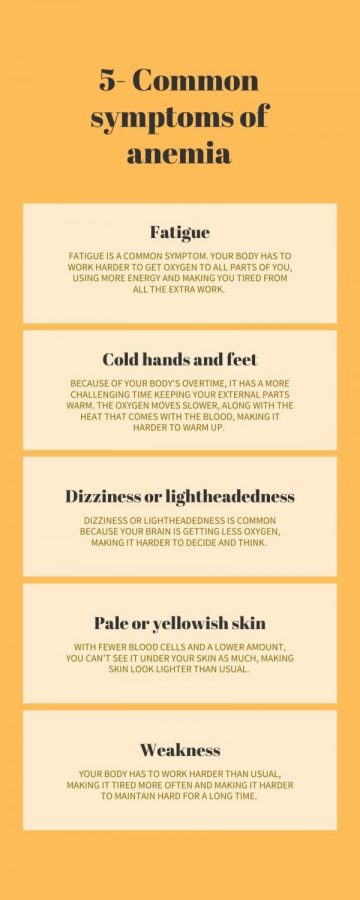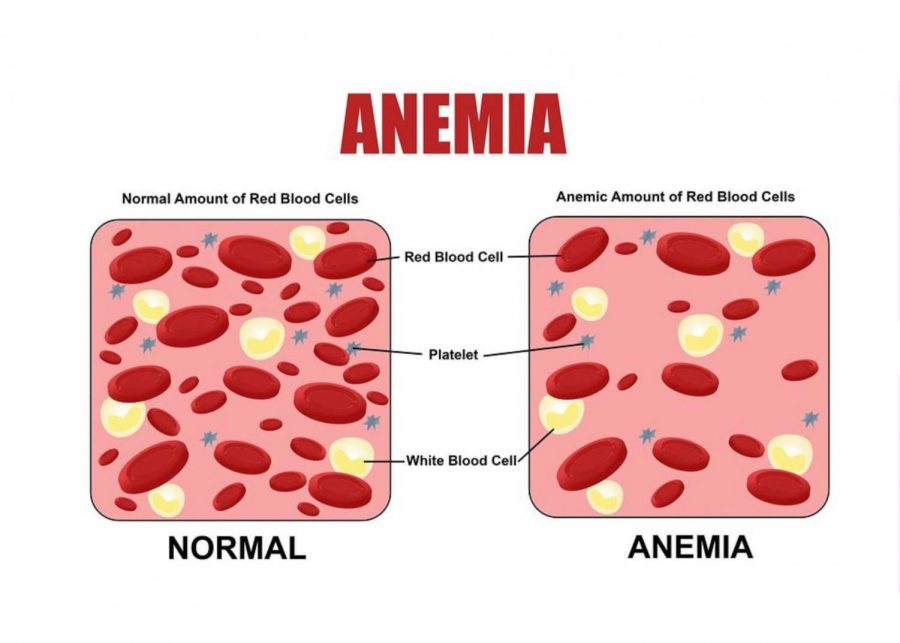Is your body in need of some iron?
Because of the low iron levels, your bone marrow can’t make as many blood cells. Your body also has a hard time making white blood cells making anemic people more susceptible to sickness. Infographic by: SelfDecode
April 20, 2021
Anemia and its effects on you.
Do you tire quickly or feel weak when doing everyday things? How are your fingers and toes feeling right now? Cold? These are just a few symptoms of the most common blood disorder in America, called iron-deficiency anemia. Iron deficiency anemia affects 3 million people in the U.S. and is most common among pregnant women or in those who have heavy menstrual periods. Babies, children and teens are also at high-risk for iron-deficiency anemia.
According to the Mayo Clinic Iron-deficiency anemia happens when the body does not make enough red blood cells or the blood cells that are produced do not work correctly. Red blood cells contain hemoglobin, a protein that makes it red and carries oxygen from your lungs to the rest of your body. Red blood cells are produced in the bone marrow. The body needs iron, vitamin B-12, folate and other nutrients from the foods we eat to create the cells. If fewer red blood cells are being made, or they don’t work, not enough oxygen is getting into the body. Oxygen makes the cells in our bodies work, allowing us to move and breathe and live. Low oxygen causes a chain reaction, to the point where a person with iron-deficiency anemia struggles to do everyday things, like take a walk or stay warm.

Iron-deficiency anemia can occur for a couple of reasons. It can be caused by excessive bleeding, where red blood cell loss occurs more quickly than they can be replaced, which can happen due to heavy menstrual cycles. It can also happen when iron-rich foods are not eaten in large enough quantities, or when an illness causes the body to not be able to absorb the iron in foods.
Sophomore Jaden Elizondo has anemia, “I was always fatigued and really cold all the time, I couldn’t warm up.” Anemia’s most common symptoms are fatigue, weakness, low body temperature and pale skin.
Jaden eventually went to see her doctor, “My doctor prescribed me iron supplements to take. I am still considered anemic, but the supplements allow me to be at the normal level needed.” To treat iron-deficiency anemia, doctors commonly prescribe iron pills like Ferrous Sulfate.
In addition to iron-deficiency anemia, there is also vitamin deficiency anemia, anemias associated with bone marrow disease and sickle cell anemia. All of these are similar because they refer to low amounts of red blood cells or vitamins in the blood.
Another student who realized they had iron-deficiency anemia is freshman Daphne Raymond, “I am still what they call ‘borderline anemic,’ sometimes when I feel it affecting me, I take an iron supplement with my meal.”
Anemia isn’t life-threatening, but if it’s not treated, it can cause lower oxygen in your whole body, making your heart work harder. Which will harm the heart over time. Some easy ways of preventing iron-deficiency anemia are changing your diet to include more iron-rich foods, such as meats, beans, lentils, dark green leafy vegetables and dried fruit. You may also consider taking a supplement to increase the levels of Vitamin B-12 and Vitamin C in your blood. Some foods that will help you absorb that iron are citrus fruits and juices, peppers, broccoli, tomatoes, melons and strawberries.
If you experience any of the symptoms listed, tiredness, weakness, dizziness or cold hands and feet, make sure to check with your doctor to get your blood drawn and discover out what’s going on. Finding out sooner than later can improve your long-term health.








![Lindsay Guzik, new assistant principal said, "I am settling in [at VHS] pretty well. I know a lot of the students, so that makes it a little bit easier coming from Cabrillo, and it's been nice to see them all grown up." Photo by: Abraham Kassa](https://thecougarpress.org/wp-content/uploads/2025/09/IMG_9728-300x200.jpg)
